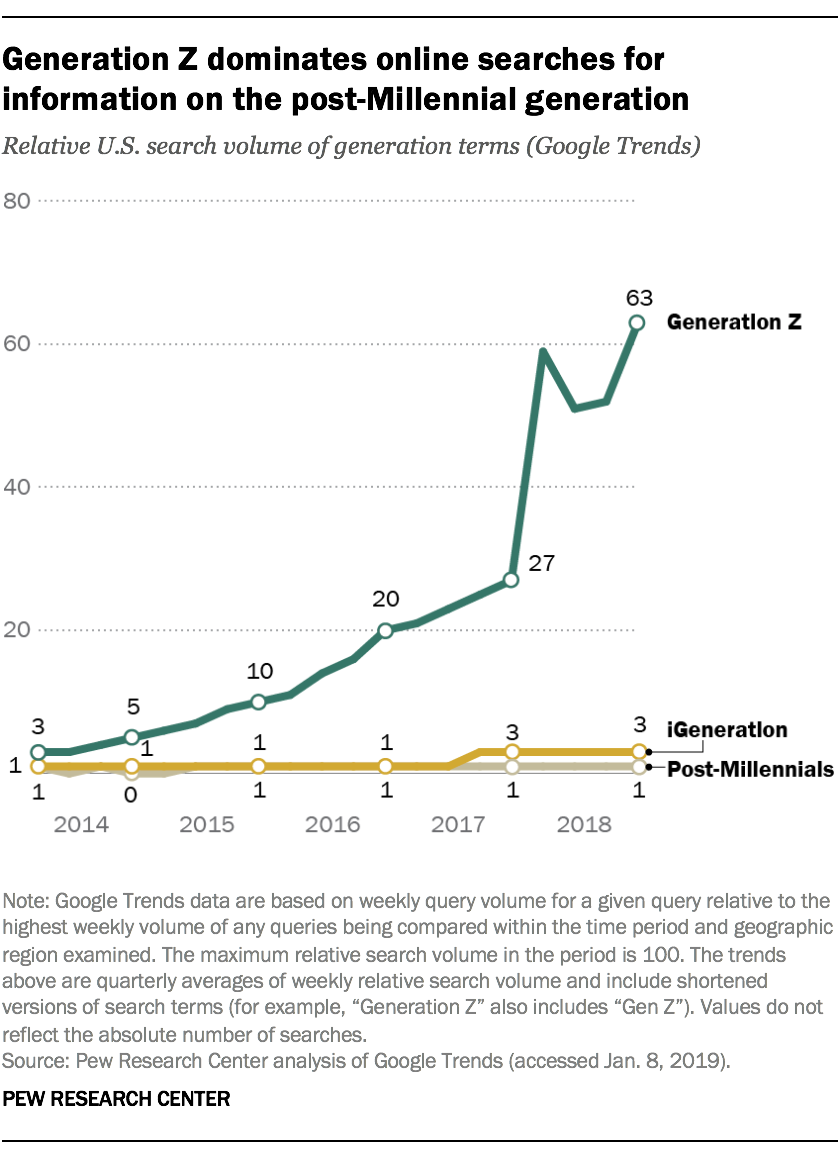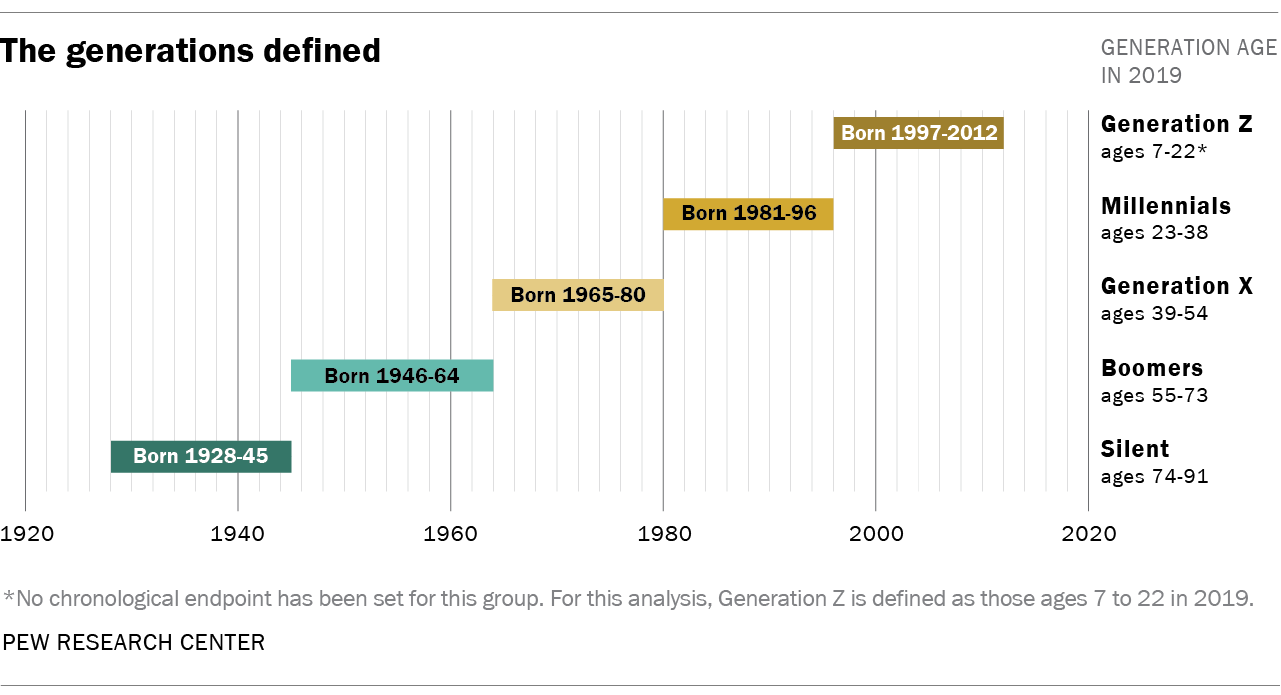_____ Refers to the Change That Family Members Make in Social Class From One Generation to the Next.
For decades, Pew Research Center has been committed to measuring public attitudes on key issues and documenting differences in those attitudes beyond demographic groups. One lens often employed by researchers at the Heart to understand these differences is that of generation.
Generations provide the opportunity to look at Americans both by their place in the life wheel – whether a immature adult, a middle-aged parent or a retiree – and past their membership in a cohort of individuals who were built-in at a similar fourth dimension.

As we've examined in by piece of work, generational cohorts give researchers a tool to analyze changes in views over time. They can provide a fashion to understand how different formative experiences (such equally earth events and technological, economic and social shifts) interact with the life-bike and aging process to shape people'due south views of the world. While younger and older adults may differ in their views at a given moment, generational cohorts allow researchers to examine how today's older adults felt well-nigh a given result when they themselves were young, also as to describe how the trajectory of views might differ across generations.
Pew Inquiry Heart has been studying the Millennial generation for more than than a decade. But by 2018, it became clear to us that information technology was time to decide a cutoff point between Millennials and the next generation. Turning 38 this twelvemonth, the oldest Millennials are well into adulthood, and they first entered adulthood before today's youngest adults were born.
In lodge to keep the Millennial generation analytically meaningful, and to begin looking at what might be unique about the next cohort, Pew Inquiry Eye decided a year ago to utilize 1996 every bit the last birth year for Millennials for our future work. Anyone built-in between 1981 and 1996 (ages 23 to 38 in 2019) is considered a Millennial, and anyone born from 1997 onward is part of a new generation.

Since the oldest among this rising generation are just turning 22 this yr, and most are still in their teens or younger, we hesitated at start to requite them a name – Generation Z, the iGeneration and Homelanders were some early candidates. (In our first in-depth wait at this generation, we used the term "post-Millennials" as a placeholder.) Simply over the by twelvemonth, Gen Z has taken concur in popular civilisation and journalism. Sources ranging from Merriam-Webster and Oxford to the Urban Dictionary at present include this proper noun for the generation that follows Millennials, and Google Trends data show that "Generation Z" is far outpacing other names in people'due south searches for data. While there is no scientific procedure for deciding when a name has stuck, the momentum is clearly behind Gen Z.
Generational cutoff points aren't an exact science. They should be viewed primarily equally tools, allowing for the kinds of analyses detailed above. But their boundaries are not arbitrary. Generations are oft considered by their span, only once more there is no agreed upon formula for how long that span should exist. At 16 years (1981 to 1996), our working definition of Millennials is equivalent in age bridge to their preceding generation, Generation X (born betwixt 1965 and 1980). By this definition, both are shorter than the span of the Baby Boomers (19 years) – the only generation officially designated by the U.S. Demography Bureau, based on the famous surge in post-WWII births in 1946 and a significant turn down in birthrates after 1964.
Unlike the Boomers, in that location are no comparably definitive thresholds by which after generational boundaries are divers. But for analytical purposes, nosotros believe 1996 is a meaningful cutoff between Millennials and Gen Z for a number of reasons, including primal political, economic and social factors that define the Millennial generation's determinative years.

Most Millennials were between the ages of 5 and 20 when the nine/xi terrorist attacks shook the nation, and many were old enough to embrace the historical significance of that moment, while about members of Gen Z have lilliputian or no memory of the issue. Millennials too grew upwardly in the shadow of the wars in Iraq and Afghanistan, which sharpened broader views of the parties and contributed to the intense political polarization that shapes the current political environment. And most Millennials were between 12 and 27 during the 2008 election, where the force of the youth vote became part of the political conversation and helped elect the first black president. Added to that is the fact that Millennials are the most racially and ethnically diverse adult generation in the nation'southward history. Yet the next generation – Generation Z – is even more diverse.
Beyond politics, most Millennials came of age and entered the workforce facing the height of an economic recession. Every bit is well documented, many of Millennials' life choices, future earnings and entrance to adulthood have been shaped past this recession in a manner that may not exist the case for their younger counterparts. The long-term effects of this "slow start" for Millennials will be a factor in American society for decades.
Technology, in particular the rapid development of how people communicate and interact, is another generation-shaping consideration. Baby Boomers grew up as television expanded dramatically, irresolute their lifestyles and connection to the globe in fundamental ways. Generation X grew up equally the computer revolution was taking hold, and Millennials came of age during the internet explosion.
In this progression, what is unique for Generation Z is that all of the to a higher place have been role of their lives from the beginning. The iPhone launched in 2007, when the oldest Gen Zers were 10. By the time they were in their teens, the primary means by which young Americans connected with the spider web was through mobile devices, WiFi and high-bandwidth cellular service. Social media, abiding connectivity and on-need entertainment and communication are innovations Millennials adapted to equally they came of age. For those born subsequently 1996, these are largely causeless.
The implications of growing up in an "e'er on" technological environment are only now coming into focus. Recent research has shown dramatic shifts in youth behaviors, attitudes and lifestyles – both positive and concerning – for those who came of age in this era. What we don't know is whether these are lasting generational imprints or characteristics of boyhood that will become more muted over the class of their machismo. Beginning to track this new generation over time will be of meaning importance.
Pew Research Center is not the get-go to draw an analytical line between Millennials and the generation to follow them, and many have offered well-reasoned arguments for drawing that line a few years earlier or later than where we have. Perhaps, as more data are collected over the years, a clear, atypical delineation will emerge. Nosotros remain open to recalibrating if that occurs. But more than likely the historical, technological, behavioral and attitudinal data will show more than of a continuum beyond generations than a threshold. As has been the case in the past, this means that the differences inside generations can be simply as smashing equally the differences across generations, and the youngest and oldest within a commonly defined accomplice may experience more in common with bordering generations than the one to which they are assigned. This is a reminder that generations themselves are inherently various and complex groups, non simple caricatures.
In the near term, you will see a number of reports and analyses from the Centre that continue to build on our portfolio of generational inquiry. Today, we issued a study looking – for the offset fourth dimension – at how members of Generation Z view some of the cardinal social and political issues facing the nation today and how their views compare with those of older generations. To be certain, the views of this generation are not fully formed and could change considerably as they age and equally national and global events arbitrate. Nonetheless, this early wait provides some compelling clues about how Gen Z will help shape the future political landscape.
In the coming weeks, we will be releasing demographic analyses that compare Millennials to previous generations at the aforementioned stage in their life cycle to run into if the demographic, economic and household dynamics of Millennials continue to stand autonomously from their predecessors. In addition, we will build on our research on teens' technology use by exploring the daily lives, aspirations and pressures today's 13- to 17-year-olds face every bit they navigate the teenage years.
Yet, nosotros remain cautious most what can be projected onto a generation when they remain so young. Donald Trump may be the showtime U.S. president most Gen Zers know as they turn 18, and simply every bit the contrast between George W. Bush and Barack Obama shaped the political argue for Millennials, the electric current political environment may accept a similar effect on the attitudes and date of Gen Z, though how remains a question. As important as today'south news may seem, information technology is more than likely that the technologies, debates and events that volition shape Generation Z are still however to be known.
We wait forwards to spending the next few years studying this generation as it enters adulthood. All the while, we'll go along in mind that generations are a lens through which to understand societal change, rather than a label with which to oversimplify differences between groups.
Note: This is an update of a post that was originally published March one, 2018, to announce the Middle's adoption of 1996 as an endpoint to births in the Millennial generation.

martinezhoppled77.blogspot.com
Source: https://www.pewresearch.org/fact-tank/2019/01/17/where-millennials-end-and-generation-z-begins/
0 Response to "_____ Refers to the Change That Family Members Make in Social Class From One Generation to the Next."
Post a Comment